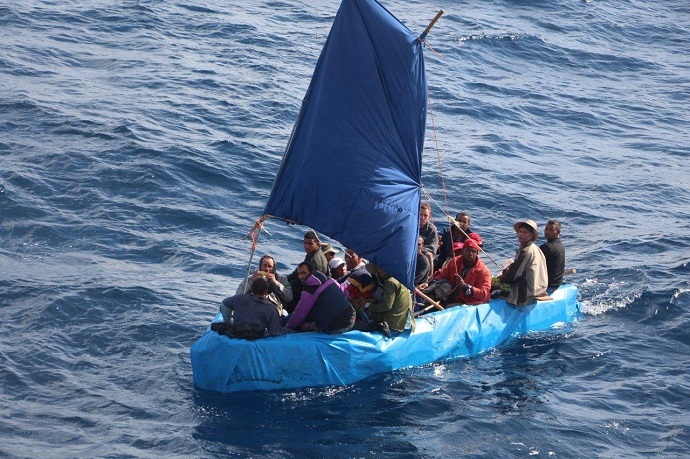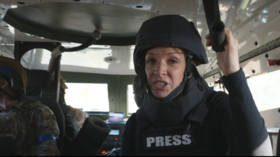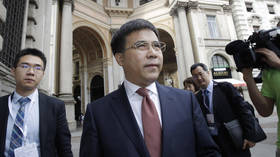Flood of ‘boat people’: US Coast Guard sees 117% rise in Cubans sailing to Florida

The US Coast Guard saw a flood of Cuban immigrants attempting to make the 90-mile trip to the shores of the United States during December, stopping 481 migrants in 37 different events ‒ a 117 percent increase from December 2013.
In just the first five days of 2015, a total of 96 Cuban migrants have been interdicted at sea in seven separate events in the Florida Straits, the US Coast Guard (USCG) announced. The Department of Homeland Security’s maritime agency repatriated 121 Cuban migrants to their home country on Monday.
“All seven interdictions included unseaworthy, homemade vessels that posed significant risk to the migrants attempting to make the perilous journey,” the USCG said in a statement.

The Coast Guard has increased patrols of US waters around Florida ‒ known as the Florida Straits ‒ since President Barack Obama announced in mid-December that the US is seeking to establish diplomatic relations with Cuba and soon plans to open an embassy in Havana, authorize sales and exports between the nations, and make changes to current travel laws that for decades have restricted traffic between the two countries.
"The Administration’s recent announcement regarding Cuba does not affect immigration policies including wet foot/dry foot or the Cuban Adjustment Act – which only Congress can change," said Rear Adm. Jake Korn, Coast Guard 7th District commander, addressing rumors that the US would abruptly end its current Cuban immigration policy as early as next Thursday.
“The Coast Guard is aggressively maintaining a presence in the region and discourages these dangerous and deadly voyages,” Korn added. “Individuals must have a visa or other permission to travel to the States and anyone located at sea will be returned to Cuba in accordance with immigration laws.”
"The Coast Guard strongly discourages attempts to illegally enter the country by taking to the sea. These trips are extremely dangerous," Capt. Mark Fedor, Coast Guard 7th District chief of response, said in the statement. "Our main goal is to support national policy of orderly, safe and legal migration through deterrence of unlawful maritime migration, including migrant smuggling."
In 1994, President Bill Clinton signed a bilateral accord with the Cuban government guaranteeing that the US consular service in Havana would issue no fewer than 20,000 immigration visas yearly to Cubans. The accord, as modified in 1995, also specified that Washington and the Castro regime would collaborate to return any Cubans found in the Florida Straits – but not those who landed in the United States. The policy became known as “Feet Wet, Feet Dry.”

“With his eyes on his impending reelection bid, Clinton sought to prevent a flood of boat people comparable to the exodus in 1980,” Reuters noted. “Public opposition to the boat people contributed to President Jimmy Carter’s failed re-election bid that year.”
“Boat people” were those who fled to the US in April 1980, when the Castro regime announced that all Cubans wishing to emigrate to the United States were free to board boats at the port of Mariel, as long as they had someone to pick them up. In all, 125,000 Cubans arrived on US shores in about 1,700 boats, “creating large waves of people that overwhelmed the US Coast Guard,” according to the History Channel. “Cuban guards had packed boat after boat, without considering safety, making some of the overcrowded boats barely seaworthy.”
During the so-called Mariel Boatlift, 27 migrants died, including 14 on an overloaded boat that capsized on May 17. A similar exodus occurred during the summer of 1994.
Cubans know the risks of the shark-infested, choppy waters between the two countries.
"I'm crazy to leave, but I'm not going to throw myself into the sea, I'm not going to do it," Juan Moreno told the Associated Press in Havana. "He who does that is crazy."
Yet illegal immigration from the Caribbean – including from Cuba – frequently spikes based on rumors, Marine Gen. John Kelly, the chief of US Southern Command, told Washington Post’s Checkpoint blog in an interview before the Obama announcement.
The US president hopes that normalizing relations between the US and Cuba after 50 years will guide the communist dictatorship towards reforms and openness.
“This is fundamentally about freedom and openness, and also expresses my belief in the power of people-to-people engagement,” Obama said while announcing the policy change, adding that he believes such “contact will ultimately do more to empower the Cuban people.”
He is looking to Mexican President Enrique Peña Nieto to join him in pressuring Cuba to make democratic reforms, the Associated Press reported. But Cuban President Raul Castro has adamantly said that democratization will not happen.
Obama and Peña Nieto met at the White House Tuesday to discuss Cuba and the newly updated US immigration policies, which the US president enacted via executive action in November. The Mexican leader has praised both of Obama’s unilateral actions in recent weeks.












